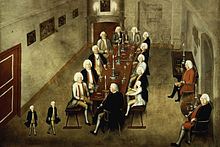Königs Wusterhausen Castle
The king Wusterhausen Castle in the same town south-east of Berlin in the state of Brandenburg was the favorite residence of the "Soldier King" Frederick William I and as a place of his tobacco colleges known. The listed building has been a museum since 2000.
History of the castle
The castle is based on a water castle from the 14th century and was first mentioned in writing in 1320. Another mention goes back to 1375 as "castrum wusterhuse" . In 1682 the property was acquired by the Great Elector Friedrich Wilhelm for his son Friedrich I , who in turn gave it to his son Friedrich Wilhelm I , who later became the "Soldier King".
The castle under the soldier king
Friedrich Wilhelm I despised the Baroque extravagance of his father, who had brought Prussia to the brink of national bankruptcy by expanding the palaces in Potsdam and Berlin . He used the simple castle in Wusterhausen as a hunting lodge and summer residence and stayed in the city residences as far as possible only in winter. Friedrich Wilhelm I came to Wusterhausen regularly for “Herbstlust”. In his honor, the place Wusterhausen received from 1717 the "king" addition in the name.
The soldier king preferred to live in this small castle, where he held his tobacco colleges and was able to distract himself from state affairs or go hunting with the training of his Tall Fellows - one of the few aristocratic pleasures he allowed himself. To safeguard the game population, he had the Neue Mühle zoo laid out in 1725 , which bordered directly on the palace gardens. But the castle was not just a place of leisure and relaxation; Here he also signed the decree in 1730 that ended the planned flight of his son Friedrich II to England with the execution of his friend Hans Hermann von Katte .
The palace after Friedrich Wilhelm I.
After the death of the soldier king in 1740, the castle fell into disrepair. Frederick II did not have fond memories of the place where he had spent part of his unhappy childhood and which constantly reminded him of his hated father. He preferred to devote himself to the expansion of Sanssouci Palace in Potsdam .
In the 19th century it was used again as a royal hunting lodge by the Prussian kings Friedrich Wilhelm IV and Wilhelm I. From 1863 court hunts took place again. The castle was repaired and refurbished.
In 1913 the last great hunt took place under Kaiser Wilhelm II . During the time of the Weimar Republic a museum was housed here for a while and during the Second World War it was used as a hospital . At the time of the German Democratic Republic it was the seat of the district administration of the Königs Wusterhausen district .
Extensive restoration work began in 1991; on September 30, 2000, the palace and garden were opened to the public again. Today there is again a center of culture there. The castle serves as a museum again. The Prussian Palaces and Gardens Foundation Berlin-Brandenburg owns the palace and the palace gardens.
Architecture of the castle
The two-storey, almost square structure was built up to the upper storey using field stones. It shows the type of “fixed house” that was mandatory for the Renaissance . The north and south sides of the building show the characteristic gable fronts of the castle with steep and parallel gable roofs. On the northern courtyard facade is the stair tower in front of it, shifted from the central axis, with a tail hood covered with slate .
In the ballroom of the palace there are around 40 paintings that the soldier king painted by hand between 1735 and 1739 in Schloss Kossenblatt and that did not reach Wusterhausen until 1863. In front of the castle are the two cavalier houses , which together form the trapezoidal castle courtyard.
Castle garden
The Renaissance garden was located to the west of the castle, while on the eastern side there was an as yet undesigned meadow area. Between 1696 and 1698, a garden in the French Baroque style was laid out on the eastern side. The client was Electress Sophie Charlotte . She sent Siméon Godeau, a student of André Le Nôtres from Paris, to design the palace gardens in Wusterhausen.
Today the baroque garden structure - in connection with the remains of the design of the 19th century and the period around 1969 - has been restored.
literature
- Gert Streidt, Peter Feierabend (Ed.): Prussia. Art and architecture . Könemann, Cologne 1999, ISBN 3-89508-424-7 .
Web links
- Entry in the monument database of the State of Brandenburg
- Königs Wusterhausen Castle
- Prussian Palaces and Gardens Foundation Berlin-Brandenburg
- Brochures and information leaflets from the Prussian Palaces and Gardens Foundation for download
- Info flyer for Königs Wusterhausen Castle to download
Coordinates: 52 ° 17 ′ 53.9 ″ N , 13 ° 37 ′ 30 ″ E






